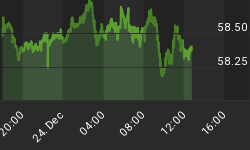Skip the supposed theory and purpose of Quantitative Easing, and ask yourself what is its equivalent weight? Suppose we use the $85,000,000,000 per month that is officially acknowledged and round it to $1,000,000,000,000 per year and relate that $1 Trillion per year to items more easily understood.
-
What is $1 Trillion expressed in tons of $1 bills?
-
What is $1 Trillion expressed in kilos of heroin at "street value"?
-
What is $1 Trillion expressed in tankers of gasoline?
-
What is $1 Trillion expressed in cases of 18 year old single malt Scotch?
-
What is $1 Trillion expressed in days for the US government to spend it?
-
What is $1 Trillion expressed in truckloads of one ounce Silver Eagles?
-
What is $1 Trillion expressed in truckloads of one ounce Gold Eagles?
You see the general idea! Let's not get bogged down in philosophical details or exact calculations; let's just relate the annual quantity of dollars created to a few commodities we can more easily recognize.
-
$1 bills: Each bill weights about 1 gram, so 1 trillion bills weigh about 1,000,000 metric tons, approximately 1,100,000 tons. Assume a freight train can haul about 100 tons per car and a train is 200 freight cars. To haul the weight of 1 trillion dollar bills would require 55 individual trains with 200 cars each.
-
Heroin: Assume heroin retails for about $75 per gram. One trillion dollars will buy about 13,000,000 kilos of heroin. Assume 1.56 g/ml (Wikipedia) and that we pack the heroin in an ocean shipping container 40 feet long with a capacity of 67 cubic meters. By my calculations, it will take about 125 of those huge containers filled with heroin to equal in street cost $1 Trillion.
-
Gasoline: Assume a gallon of gasoline is $4 at the pump. Assume a tanker truck on the highway can move 10,000 gallons of gasoline. At that rate, it would take about 25,000,000 tanker trucks filled with gasoline to equal $1 trillion in gasoline. If those trucks were lined up on the highway allowing for 200 feet in truck length plus safety distance between trucks, the line of trucks would extend 940,000 miles or back and forth across the country over 300 times.
-
Scotch: Assume good Scotch at $100 per bottle or $1,200 per case. Assume we pack our expensive Scotch in 40 feet long ocean containers. With tight packing we can estimate about 1,600 cases per container. That makes each container worth, in round numbers, about $2,000,000; that means we would need 500,000 containers loaded with this scotch to equal the $1 Trillion per year in QE.
-
Spending: Assume the US government spends $3.7 Trillion per year. At that rate, the government spends $1 Trillion in about 100 days.
-
Silver Eagles: Eagles vary in price, but assume a current price is $30 per Eagle (one ounce of silver). Eagles come packed in "monster" boxes of 500 coins. Assume an 18 wheeler will transport about 50,000 pounds per load. At that rate, one load is about 1,600 "monster" boxes and worth about $24,000,000. The $1 Trillion of QE is the equivalent of over 40,000 trucks hauling Silver Eagles from the US Mint to your home, which is roughly 40 times the world's annual mining production.
-
Gold Eagles: Assume a current price for a Gold Eagle is about $1,600. If our 18 wheeler can haul 50,000 pounds or around 800,000 ounces, then each truck load of Gold Eagles is worth about $1,250,000,000. The $1 Trillion in QE is equivalent to about 800 trucks filled with gold. It would be difficult to locate that much gold since that amount of gold is about eight times the world's annual mining production.
Conclusion
Our current Quantitative Easing process is creating about $85,000,000,000 in digital currency each month or about $1 Trillion per year. Visualize the Federal Reserve policy as creating:
-
55 long trains stuffed with $1 bills or one train of about 100 cars stuffed with $100 bills.
-
125 large (40 foot) containers filled with heroin, calculated at "street value."
-
Half a million large (40 foot) containers of good Scotch.
-
8 times the world's annual production of gold.
-
An unknown amount of inflation and consumer price increases.
About half a century ago we could buy a cup of coffee for $.15, gasoline for $.19, and a new car for under $2,000. What changed was the value of the money. We increased spending, budget deficits, national debt, and the money in circulation, and prices increased as a result. We have been warned!
And yes, It's Going To End Badly.
















